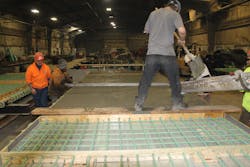The Liberty Bridge over the Monongahela River opened for traffic in 1928 and is credited (along with the Liberty Tunnel) as an instrumental door opening Pittsburgh’s yet undeveloped South Hills area to expansion. At the time, the bridge was to be the highest and costliest, and its 2,663-ft total length would be the longest built in the city.
Today, the Liberty Bridge is again making local history as Pennsylvania’s first Exodermic deck to be installed. As one of Pittsburgh’s major arteries, it was imperative to minimize disruption to traffic, so an Exodermic deck was selected as a proven accelerated bridge construction product. BGFMA certified fabricator LB Foster (LBF), Pittsburgh, supplied over 170,000 sq ft (1,158 panels) of grid deck for the project. There were 948 panels delivered directly to the bridge where local contractor Joseph B. Fay replaced the main span deck (spans 4-11) with cast-in-place techniques in four stages, one lane at a time. Maintaining three lanes during the day, at night Fay could shut down an additional lane, which was used for setting deck panels, offloading supplies and pouring concrete. The contractor made great use of the closure. For instance, during stage 3 construction on spans 4-11, all of the cast-in-place panels, approximately 17,000 sq ft, were set and leveled by a four-man crew in a matter of 20 hours.
Due to the limited roadway width of the mainline portions of spans 12-14, the Exodermic deck was installed with precast panels and an accelerated concrete mix for closure pours. This critical section of the bridge, which transitions into the Crosstown Connector on the Pittsburgh side of the bridge, was constructed under weekend closures. Local precaster Concrete Concepts Inc., a division of Bryan Materials Group, McKees Rocks, Pa., received 210 panels from LBF and precast the panels at their facility under controlled conditions.
In addition to speed of construction, the deck replacement project is capitalizing on another advantage of grid reinforced concrete decks, and that is its high strength to weight ratio. The Liberty Bridge is currently load rated to 30 tons and has been on the state’s structurally deficient list with some major steel deterioration that is being corrected under this contract. By maximizing this strength/weight ratio advantage utilizing lightweight concrete, design engineers at HDR, Pittsburgh, were able to increase the stringer spacing up to 9 ft 9 in. in some locations and integrate the spacing into a harmonized maintenance of traffic control plan.
The entire deck surface will receive an LMC overlay and, in addition to the deck replacement, the Liberty Bridge is being repainted. Construction is scheduled into 2018.



